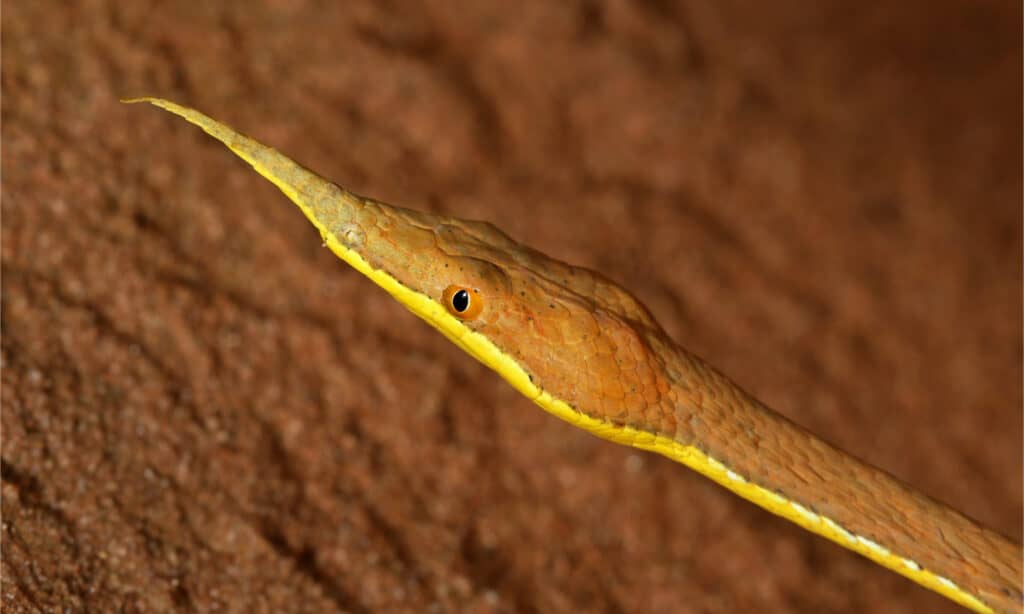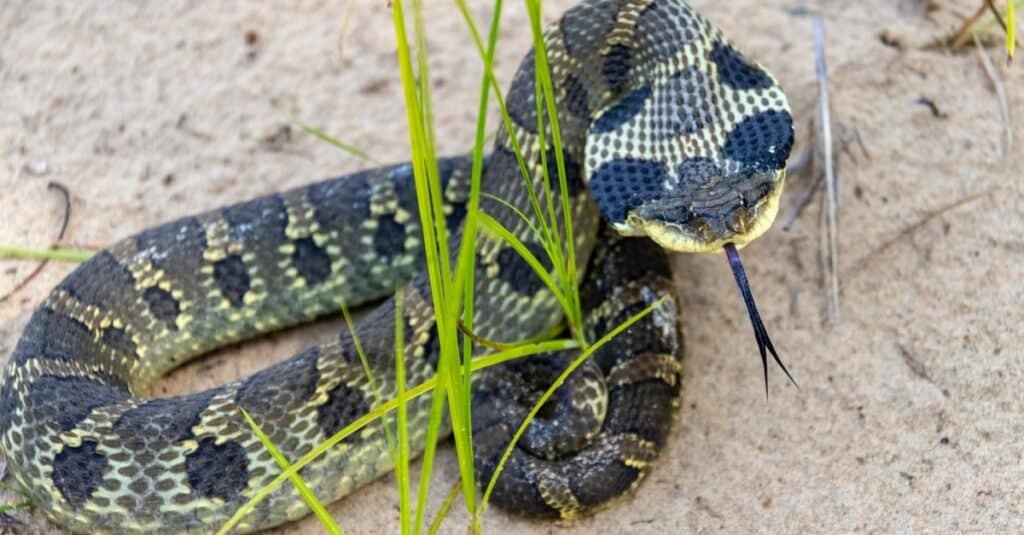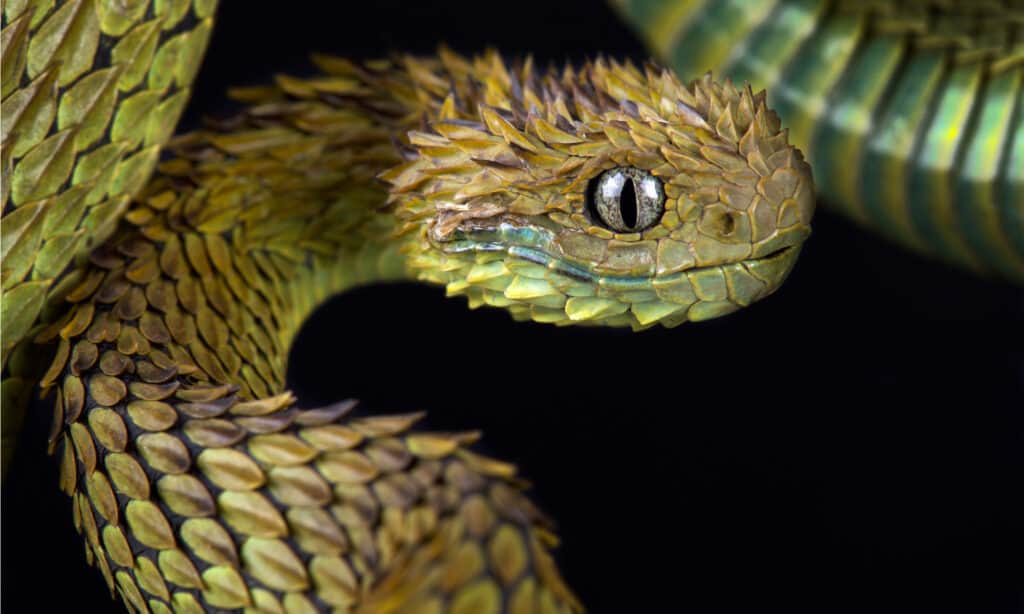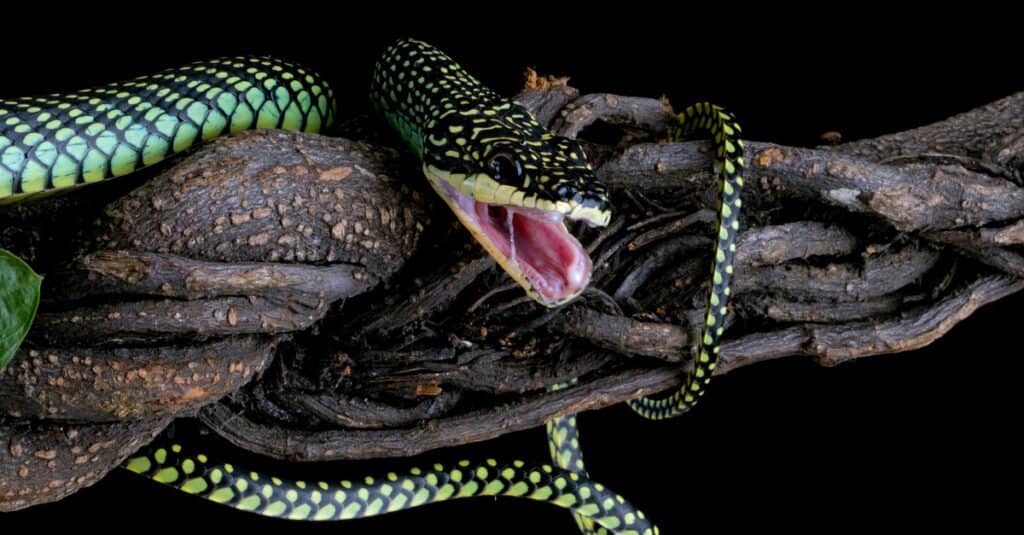One of the major reasons to love snakes is how every species seems to be different. Some are venomous and some aren’t while some others have fangs and the rest don’t. Similarly, some snakes have really weird noses that others don’t have.
Snakes use their noses primarily to breathe. Their mouths and tongues are used to smell, eat, and threaten their prey and predators. Snakes have noses of different shapes, sizes, and even apparent numbers. Here are 9 Snakes with the weirdest noses.
9 Snakes with the Weirdest Noses
Malagasy Leaf-nosed Snake

Malagasy leaf-nosed snakes get their names from their leaf-like noses.
©Ryan M. Bolton/Shutterstock.com
Male and female Malagasy leaf-nosed snakes get their names from their weird noses. Although male and female Malagasy snakes have different types of nostrils, both are still unique.
The male Malagasy snake has brown and yellow patterns on its scales while females are mostly colored a dark shade of gray. Males have slightly curved or tapered snouts. The females have leaf-shaped and flat noses.
Sharp-Nosed Viper

Sharp-nosed vipers have sharp-looking and upturned snouts or noses.
©Ondrej Prosicky/Shutterstock.com
Although its name gives an idea of how it looks, the sharp-nosed viper still amazes people when seen up close. Not only does the snake have distinct triangular markings all over its body, but it also has a sharp-looking and upturned snout gracing its triangular head.
The sharp-nosed viper, as you might imagine, is venomous. It is often called the “hundred-pacer” or “fifty-pacer” because it was locally believed that anyone bitten by the sharp-nosed viper will only be able to walk a hundred steps before dying.
Did you know: Locals bitten by this snake often needlessly cut or bite off the bitten parts to stop the venom spread. This often causes even more problems than the venom as amputations cannot be undone. If you’re bitten by a sharp-nosed viper, get medical help as soon as you can, and do not bite off any parts of your body.
Eastern Hognose Snake

Eastern hognose snakes have upturned noses which they use to dig sand.
©IHX/Shutterstock.com
The eastern hognose snake has a lot of distinctive features. They come in varying attractive colors such as orange, gray, and brown. Sometimes, they even mix all three. However, the most distinctive feature of these reptiles, as you might have guessed, is their nose. They have upturned snouts that are often used to dig the soil.
These snakes are also rather dramatic and often play dead by going completely limp. We call them dramatic because they ensure to give a full show by letting their tongues hang from their open mouths. Luckily, these amazing animals are harmless to people and make good pets.
Copperhead

Copperheads appear to have four nostrils but don’t.
©Creeping Things/Shutterstock.com
One look at a copperhead might have you thinking that this snake has four nostrils. Several people believe this untruth and a good look at the copperhead snake is enough to tell why. In between their eyes and nostrils, copperheads have pits on either side. Although they resemble nostrils, they are not. They are called heat-sensing pits.
Copperheads make use of their heat-sensing pits to locate or sense heat in the body of mammals so they can hunt them at night when they cannot see. They are more active at night. Without their heat-sensing pits, they would not be able to hunt effectively.
Tentacled Snake

Tentacled snakes have tentacles on their noses.
©Keung/Shutterstock.com
The tentacled snake is a very popular species and it is easy to see why. They are rather small reptiles that can be found in the murky waters of southeastern Asia. They are also the only species with two tentacles in front of their noses. These tentacles have mechanosensory functions. This simply means that they can sense stimuli such as pressure and vibration.
The species has really unique colors too. They are either light brown with deep-colored stripes or deep-colored with brown stripes.
Bush Viper

Bush vipers have two nostrils which are separated by keeled scales.
©reptiles4all/Shutterstock.com
Several things are eye-catching about the bush viper. The species is found only in the tropical sub-Saharan parts of Africa. Bush vipers are usually colored green or brown and have keeled or raised scales. They have tiny slits for noses that are separated by even more scales.
Bush vipers are incredibly venomous. A single bite from them can be fatal as their venom contain toxins that can induce hemorrhaging of organs. In the case of a serious bite, swelling and bleeding often occur, accompanied by intense pain.
Flying Snakes

Flying snakes have distinctively flat noses which fit perfectly on their flat bodies.
©Kurit afshen/Shutterstock.com
Known for their unique abilities to glide in the air, these colubrids aren’t like any other snakes in several ways. Flying snakes glide through the air at a speed of 25 miles per hour by flattening their ribs to stretch and flatten the rest of their bodies. They are only in the air for a few seconds at a time but no other snake species does this.
Flying snakes are another species with weird noses. Their noses are blunt and almost seem to blend into their faces. These tree snakes are venomous, although their venom is light and only fatal to their small prey.
Malagasy Blind Snake
The Malagasy blind snake, which is only naturally found in Madagascar, is one of the smallest snake species known to man. The smallest species, of course, is the Barbados threadsnake. This snake is no larger than an earthworm.
Although not much is known about this snake species, what we do know is exciting enough. It has a small nose that is fully armored with scales. This, of course, enlarges and flattens the nose and makes it look like a bulldozer. Malagasy blind snakes are also called Madagascar worm snakes or Madagascar blind snakes and measure up to 9.8 inches and are critically endangered.
Long-Nosed Snake

The long-nosed tricolor snake gets its name from its long and slightly upturned nose.
©jokerbethyname/Shutterstock.com
The long-nosed snake, which is also called the Texas long snake, is a tricolor, nonvenomous snake species that is commonly found in Texas primarily, in Mexico, and other areas. The snake gets its name from its very distinctive nose. It has a long nose that slightly curves to the top.
Although these snakes aren’t well-known, they make excellent pets. They are usually 39 to 60 inches long and are very docile. Long-nosed snakes hardly bite and would rather flee in confrontations, except when hunting. If you have a long-nosed snake as a pet, be sure to avoid leaving live food in their cage. If your snake isn’t hungry or ready to eat, even a small mouse can attack and injure it!
The photo featured at the top of this post is © PACO COMO/Shutterstock.com
Discover the "Monster" Snake 5X Bigger than an Anaconda
Every day A-Z Animals sends out some of the most incredible facts in the world from our free newsletter. Want to discover the 10 most beautiful snakes in the world, a "snake island" where you're never more than 3 feet from danger, or a "monster" snake 5X larger than an anaconda? Then sign up right now and you'll start receiving our daily newsletter absolutely free.
Thank you for reading! Have some feedback for us? Contact the AZ Animals editorial team.







